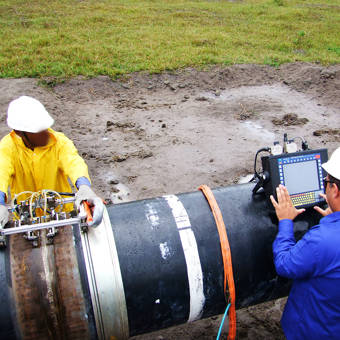Comprehensive Summary of Pipe Welding Evaluation Treatments
Pipe welding examination procedures play an important duty in assuring that welded links fulfill stringent industry criteria and requirements. From careful pre-welding examinations to extensive post-weld evaluations, a distinct examination process is essential for maintaining the architectural stability of pipes.
Pre-welding Inspection Preparations
Before beginning the welding process, thorough pre-welding evaluation prep work are important to make sure the integrity and quality of the weld joint. These prep work include a thorough evaluation of the materials to be bonded, the welding devices, and the workplace. The materials need to be evaluated for any defects, contaminants, or inconsistencies that might compromise the weld. This consists of checking for proper material qualities, dimensions, and surface area problems. Pipeline Welding Inspection. Additionally, the welding equipment needs to be inspected to validate that it is in excellent functioning condition, adjusted properly, and ideal for the certain welding procedure. Any concerns with the equipment must be dealt with immediately to stop defects in the weld. Finally, the workplace must be evaluated for sanitation, correct air flow, and safety actions to guarantee a favorable setup for the welding operation. By performing extensive pre-welding inspection preparations, prospective concerns can be identified and dealt with at an early stage, leading to top notch and reliable weld joints.
Welding Treatment Certification
Extensive pre-welding evaluation preparations lay the foundation for the important process of Welding Procedure Certification, ensuring the honesty and high quality of the weld joint. Welding Treatment Certification (WPQ) is a vital action in the welding procedure that involves testing and licensing welding treatments to assure they meet details requirements and requirements. The WPQ procedure usually consists of welding procedure requirements growth, welding treatment credentials testing, and documentation of the outcomes.
During welding procedure requirements growth, important details such as the welding procedure, welding materials, joint layout, and welding parameters are specified to create a detailed treatment. Ultimately, welding treatment certification screening is carried out to validate the recommended procedure's honesty. This testing typically entails welding test vouchers that undergo different mechanical and non-destructive examinations to evaluate the weld's high quality and adherence to the specified requirements.
In-process Weld Assessment
Throughout the welding procedure, in-process weld evaluation plays a crucial function in making certain the top quality and honesty of the weld joint - Pipeline Welding Inspection. This kind of examination entails checking the welding specifications, assessing the weld bead development, and detecting any type of possible defects or interruptions as they take place. By performing in-process weld assessments, welding drivers can quickly resolve any issues that may arise, therefore preventing further problems and guaranteeing that the last weld fulfills the needed specs
Common approaches used for in-process weld examination consist of aesthetic evaluation, liquid penetrant screening, magnetic particle screening, ultrasonic screening, and radiographic screening. Aesthetic evaluation is frequently the first action while doing so, enabling examiners to aesthetically examine the weld for surface abnormalities such as fractures, porosity, or insufficient fusion. Much more advanced approaches like ultrasonic screening and radiographic testing supply comprehensive insights into the internal framework of the weld, making sure that there are no concealed flaws that might endanger the weld joint's stamina and honesty. On the whole, in-process weld evaluation is vital for preserving the top quality and dependability of bonded pipes.
Non-destructive Testing (NDT)
Non-destructive Testing (NDT) is a crucial approach used in pipe welding assessment to analyze the integrity of weld joints without causing damage to the welded framework. By making use of numerous NDT methods, examiners can evaluate the quality of welds and determine any kind of flaws or gaps that may compromise the architectural soundness of the pipe. Usual NDT techniques made use of in pipeline welding inspection include Radiographic Testing (RT), Ultrasonic Testing (UT), Magnetic Particle Examining (MPT), Fluid Penetrant Screening (LPT), and Visual Testing (VT)
RT involves the use of X-rays or gamma rays to create photos of the internal structure of the weld, permitting examiners to spot flaws such as porosity, fractures, or incomplete fusion. UT utilizes high-frequency sound waves to find flaws below the surface area of the weld, offering in-depth information regarding the dimension and location of issues. MPT and LPT are used to determine surface-breaking flaws by applying penetrant liquids or magnetic particles to the weld area. Furthermore, VT entails visual evaluation of welds to determine any kind of visible blemishes.
Post-weld Examination and Paperwork


Documents of post-weld evaluation findings is necessary for preserving quality assurance records and making sure compliance with sector requirements and laws. Thorough records need to include information about the examination approaches made use of, the area and nature of any type of problems found, and any restorative activities taken - Pipeline Welding Inspection. Proper documents not just acts as a document of the weld's high quality click here for info however also aids in future upkeep and evaluation procedures
Conclusion

In conclusion, pipe welding evaluation procedures play an essential function in making certain the top quality and integrity of welds. On the whole, adherence to correct examination procedures is vital to the success of pipeline welding tasks.
From careful pre-welding assessments to extensive post-weld analyses, a distinct inspection procedure is essential for preserving the architectural soundness of pipelines. By performing in-process weld examinations, welding drivers can immediately attend to any kind of issues that may emerge, therefore ensuring and preventing additional problems that the final weld satisfies the called for specs.
Usual techniques used for in-process weld examination continue reading this consist of visual evaluation, liquid penetrant screening, magnetic fragment screening, ultrasonic screening, and radiographic screening.Non-destructive Testing (NDT) is a critical method utilized in pipe welding assessment to analyze the integrity of weld joints without causing damages to More about the author the welded structure. Post-weld examination entails numerous approaches to examine the welds for problems, including aesthetic inspection, color penetrant screening, magnetic bit screening, ultrasonic screening, and radiographic screening.
Comments on “Extensive Pipeline Welding Inspection Solutions for Industrialized Projects”